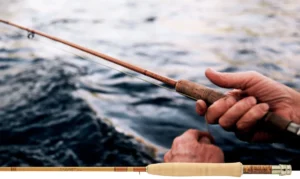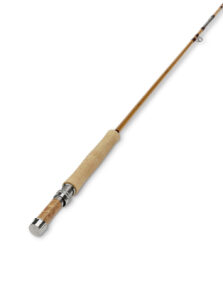
“File:FlyFishermanHookedUp.jpg …” from commons.wikimedia.org and used with no modifications.
Key Takeaways
-
Bamboo rods offer a traditional feel and delicate presentation, ideal for small streams.
-
Fiberglass rods provide durability and a modern approach to fly fishing, with a more forgiving action.
-
Understanding the unique attributes of each material can significantly enhance your fishing experience.
-
Proper care and maintenance of your rod will ensure its longevity, whether bamboo or fiberglass.
-
Matching the rod to your fishing style and the streams you frequent is crucial for the best experience.
The Quest for the Perfect Small Stream Fly Rod: Bamboo vs Fiberglass
Imagine the quiet murmur of a crystal-clear stream as it meanders through a lush forest. The air is fresh, and the gentle rustle of leaves accompanies the rhythmic dance of casting a fly rod. Small stream trout fishing isn’t just about the catch; it’s about the experience, the connection with nature, and the joy of the perfect cast. But to make that cast, you need the right tool. In the world of fly fishing, the debate between bamboo and fiberglass rods is as old as the hills yet as fresh as the morning dew. Let’s delve into what makes each material unique and how they can elevate your small stream adventures.
Understanding Your Quarry: Small Stream Trout
Small stream trout are wily creatures, often spooked by the slightest disturbance. They lurk in the shadows, darting out for a meal before quickly retreating. To catch these elusive beauties, precision and stealth are your best allies. Your rod needs to be an extension of your arm, capable of delicate presentations and subtle maneuvers. This is where the material of your rod becomes paramount.
Action and Sensitivity: Essentials of a Good Fly Rod
Action and sensitivity are the heart and soul of a fly rod. They dictate how the rod flexes and responds to the movements of both the angler and the fish. For small stream fishing, you want a rod that can present a fly gently, respond to the lightest tug, and give you the control to place your fly exactly where you want it. Whether you choose bamboo or fiberglass, these characteristics are key to your success on the water.
Head-to-Head: Comparing Rod Attributes
When deciding between bamboo and fiberglass rods, consider several key attributes that will impact your fishing experience. Each material offers distinct advantages, and understanding these can help you make an informed decision tailored to your fishing needs and preferences.
Let’s break down the core attributes of each type of rod:
-
Flexibility and Action: Bamboo rods have a slower action, flexing throughout their length, which is perfect for gentle presentations. Fiberglass rods typically offer a medium to medium-fast action, providing a good balance of power and delicacy.
-
Weight: Bamboo rods are generally heavier, which can be tiring during a long day of casting, while fiberglass rods are lighter and easier on the arm.
-
Durability: Fiberglass is more durable and less susceptible to damage from impacts or environmental factors compared to bamboo.
-
Sensitivity: Bamboo rods are highly sensitive, giving you a better feel for subtle takes. Fiberglass, while still sensitive, doesn’t quite match the ‘connected’ feel of bamboo.
-
Maintenance: Bamboo requires more care to maintain its integrity, while fiberglass is low-maintenance and more forgiving of rough handling.
Each of these attributes plays a role in how you’ll interact with your environment and the fish. Keep them in mind as you consider which rod will best suit your small stream adventures.
Weight and Balance in Your Hand
The weight and balance of a rod are crucial for control and comfort, especially when you’re casting for hours on end. Bamboo rods have a heft to them that, while providing a smooth casting rhythm, can become burdensome over time. In contrast, fiberglass rods are lighter, making them easier to wield all day without fatigue. This can be a deciding factor if you’re the type to lose track of time and spend the whole day on the water.
Precision Casting in Tight Spots
Small streams often require precise casts in tight spots. Bamboo’s slower action allows for pinpoint accuracy but demands skill and patience. Fiberglass, with its more moderate action, offers a bit more speed, which can be helpful when you need to make a quick cast in a tight window between overhanging branches and tumbling boulders.
Both materials have their place in the small stream setting, and often it comes down to personal preference and casting style. Some anglers prefer the methodical approach that bamboo encourages, while others enjoy the slightly faster pace that fiberglass affords.
Presenting the Fly: Delicacy vs. Versatility
The way you present your fly can make or break your success on a small stream. Bamboo rods excel in delivering flies with a delicate touch, landing them on the water’s surface without a ripple. This is essential when targeting skittish trout that spook at the slightest disturbance.
Fiberglass, while still capable of gentle presentations, offers a bit more versatility. Its resilience allows you to switch between delicate dry fly presentations and more aggressive nymphing or streamer techniques without needing to change rods. This adaptability can be a significant advantage when the trout’s feeding behavior changes throughout the day.
The Aesthetics: Look and Feel
Beyond functionality, there’s an aesthetic appeal to consider. Bamboo rods have a classic, timeless beauty that many anglers find irresistible. The warm tones of the wood and the craftsmanship that goes into each rod speak of tradition and a deep connection to the sport’s history.
Fiberglass rods, on the other hand, have a retro charm that’s also appealing. They come in a variety of vibrant colors and finishes, allowing you to express your personality on the water. While looks aren’t everything, there’s no denying that fishing with a rod you find visually pleasing adds to the overall enjoyment of the experience.

Getting to Know Bamboo Fly Rods
Bamboo fly rods are the stuff of legend. Crafted from natural materials, each rod is a work of art, steeped in tradition and history. When you hold a bamboo rod, you’re not just holding a fishing tool; you’re holding a piece of angling heritage.
But bamboo rods aren’t just about nostalgia. They’re known for their unparalleled sensitivity and smooth action. When you cast a bamboo rod, it bends deeply, loading slowly but surely, and then uncoils with a graceful ease that’s almost poetic. This slow action is perfect for the delicate presentation needed in small streams, where the splash of a poorly placed cast could send your quarry darting for cover.
History and Craftsmanship
Bamboo rods have a rich history, dating back to the late 1800s. They were the first rods to allow anglers to cast a line with precision and were handcrafted by artisans who spent years perfecting their craft. Today, the best bamboo rods are still made by hand, with a level of attention to detail that’s hard to find in our mass-produced world.
Why Choose Bamboo for Small Streams
So why choose bamboo for your small stream adventures? It’s all about the feel and the finesse. Bamboo rods offer a connection to the water that’s hard to describe but impossible to ignore. They allow you to cast with precision and delicacy, laying your fly on the water’s surface like a falling leaf. And when a trout takes your fly, the sensitivity of bamboo gives you the feedback you need to set the hook without hesitation.
But bamboo isn’t just about performance. It’s also about the experience. There’s something special about fishing with a rod that’s been crafted by hand, a rod that has a story. It’s a reminder of the simpler times and the enduring traditions of fly fishing.
Handling and Care for Bamboo Rods
Of course, owning a bamboo rod also means taking care of it. Bamboo is a natural material, and it requires a bit of extra attention to keep it in top condition. After each use, it’s important to clean your rod and store it properly. With the right care, a bamboo rod can last a lifetime, becoming an heirloom you pass down to the next generation of anglers.
When to Opt for Fiberglass Over Bamboo
While the allure of bamboo is strong, there are times when fiberglass is the better choice. If you’re fishing in conditions where your gear is likely to take a beating – think bushwhacking through dense foliage or clambering over rocky streambeds – the robustness of fiberglass comes into play. It’s tough, can handle accidental knocks, and is less prone to breakage. Fiberglass rods also have a ‘forgiving’ action, which is beneficial for beginners learning to cast, as it’s more tolerant of errors.
Another scenario where fiberglass shines is when you’re targeting larger fish that require a sturdier rod to bring them to hand. The modern fiberglass rod is designed to offer a blend of flexibility and strength, making it capable of handling the spirited fight of a bigger trout without sacrificing too much of the sensitivity that makes fly fishing so enthralling.
Maintenance Tips for Fiberglass Rods
Maintaining a fiberglass rod is straightforward, making it a great option for anglers who prefer minimal upkeep. Always rinse your rod with fresh water after use, especially if you’ve been fishing in saltwater or muddy conditions. This will prevent any build-up of grime that could affect the rod’s action over time. Once clean, make sure the rod is completely dry before storing it away to avoid any mildew or mold growth.
Periodically check the guides and ferrules – that’s where the different sections of the rod join together – to ensure they’re secure and free of debris. If you take good care of your fiberglass rod, it will remain a reliable companion on many fishing trips to come.

Your Next Cast: How to Decide Which Rod Is for You
Choosing between a bamboo and a fiberglass rod isn’t just about weighing their attributes. It’s also about considering how each rod aligns with your fishing style and the environments you frequent. Here’s how to make that decision:
First, think about the streams you fish. Are they tight and overgrown, requiring precise, short casts? Or are they more open, where you have room to let your line unfurl? The size and character of the stream will influence the action and length of the rod that’s best for you.
Analyzing the Streams You Fish
Take a moment to reflect on the streams you’re most likely to fish. Are they defined by narrow channels and dense foliage, or are they wider with more space for casting? Bamboo rods are a dream for the former, allowing for precise, delicate presentations in confined spaces. However, if you’re often casting in more open waters, a fiberglass rod might give you the edge with its versatility and ease of handling.
Also, consider the types of flies you use and the fish you’re after. Dry flies and small trout are a match made in heaven for bamboo, while larger flies and fish might call for the robustness of fiberglass.
Matching the Rod to Your Fishing Style
Your fishing style is deeply personal and evolves with experience. If you savor the slow-paced, meditative aspect of fly fishing, where every cast is a deliberate act of art, bamboo might be your soulmate. But if you’re more about the thrill of the hunt, constantly adapting to the changing conditions, and sometimes needing to cast with gusto, fiberglass could be your best ally.
Don’t be afraid to try both materials. Many seasoned anglers have a selection of rods to choose from, each with its own purpose and charm. What matters most is that the rod feels right in your hands and enhances your connection with the water and the fish.
Consideration of Budget and Value for Money
Let’s talk turkey. Bamboo rods are often more expensive than fiberglass due to the labor-intensive process of their creation. They’re an investment, both financially and emotionally. If you’re on a budget or just starting out, a fiberglass rod can provide excellent performance at a more accessible price point.
That said, don’t let the initial cost be the only factor. Think about the value you’re getting for your money. A well-crafted bamboo rod can last a lifetime with proper care, potentially offering better long-term value. Conversely, fiberglass rods are durable and require less maintenance, making them a practical choice for many anglers.
Ultimately, whether you choose bamboo or fiberglass, the value comes from the joy it brings to your fishing experiences. Choose the rod that calls to you, that feels like an extension of your own spirit on the water. That’s the rod that’s worth every penny.
Fishing Rods on the Market: Recommended Picks
When it comes to choosing the right rod for small stream trout, the market offers a plethora of options. Each rod has its own set of characteristics that can either enhance or hinder your fishing experience. With that in mind, let’s take a look at some of the top picks available today.
For those who have decided on bamboo, there are a few key factors to consider: the quality of the cane, the expertise of the rod maker, and the rod’s action. A well-made bamboo rod is not only a fishing tool but also a piece of art. On the other hand, when opting for fiberglass, you’ll want to focus on the rod’s durability, flexibility, and weight.
It’s worth noting that while recommendations are helpful, the best rod for you is one that feels right in your hands and suits your fishing style. Whether you’re wading into the world of bamboo or fiberglass, be sure to handle a few rods and even cast with them if possible before making your final decision.
Top Bamboo Rods for Small Stream Enthusiasts
For those drawn to the classic feel of bamboo, the Orvis Penn’s Creek Full-Flex Bamboo Rod is a standout choice. Its full-flex action allows for delicate presentations, and its craftsmanship is impeccable. Another excellent option is a Winston Bamboo Rod, which offers a balance of sensitivity and strength, perfect for the varied demands of small stream fishing.
Leading Fiberglass Rods for Durability and Performance
If fiberglass is more your speed, the Redington Butter Stick has earned its reputation for smooth casting and resilience. Its retro styling is matched by its modern performance. Another great pick is the Echo River Glass Fly Rod, known for its medium-fast action and versatility, making it a solid choice for anglers who frequent different types of small streams.
Frequently Asked Questions
As you delve into the world of small stream fly fishing, you may find yourself pondering a few common questions. Here’s a bit of wisdom to guide you along the way.
-
Can I use the same techniques with a bamboo rod as with fiberglass?
-
How do I know if a rod has the right action for small streams?
-
Is there a considerable difference in price between bamboo and fiberglass rods?
-
How long do bamboo and fiberglass rods last with proper care?
-
Are there any specific brands known for superior small stream rods?
These questions touch on the nuances of fly fishing, which can be as much about personal preference as it is about technique and gear.
Can I use the same techniques with a bamboo rod as with fiberglass?
Most techniques are transferable between bamboo and fiberglass rods, but remember that each material has its own feel and flex. Bamboo’s slower action is ideal for delicate presentations and dry fly techniques, while fiberglass offers more versatility for a range of techniques, including nymphing and throwing streamers. Adapt your approach to the rod’s characteristics for the best results.
Here’s a tip: practice your casting with both types of rods. You’ll notice that timing and rhythm are different, and adjusting your technique will be key.
-
Slow down your casting stroke with bamboo.
-
With fiberglass, you can be a bit more forceful, especially when casting larger flies.
Experiment and find what works best for you and the rod you’ve chosen.
How do I know if a rod has the right action for small streams?
The right action for small streams is one that allows for precise casting in tight spaces and delicate presentations. Typically, a slower to medium action rod will offer the control and finesse required. When testing rods, pay attention to how they load at short distances and their ability to place a fly accurately.
Is there a considerable difference in price between bamboo and fiberglass rods?
Yes, generally speaking, bamboo rods are more expensive than fiberglass due to the intensive labor and craftsmanship involved. Bamboo rods can range from a few hundred to several thousand dollars, while fiberglass rods are often available for under a few hundred dollars. However, price can vary widely based on brand, quality, and model.
How long do bamboo and fiberglass rods last with proper care?
With proper care, both bamboo and fiberglass rods can last for decades. Bamboo rods require regular maintenance, including careful cleaning and storage, to prevent warping and damage. Fiberglass rods are more forgiving but still benefit from regular cleaning and inspection. Ultimately, the lifespan of your rod will depend on how well you maintain it and how often it’s used.
Are there any specific brands known for superior small stream rods?
Several brands are renowned for their quality small stream rods. Orvis, Winston, and Thomas & Thomas are a few names that stand out in the bamboo rod market. For fiberglass, look towards Redington, Echo, and Scott for rods that have earned high praise from anglers. It’s always a good idea to research and read reviews from fellow fly fishers to find the rod that’s just right for your needs.





